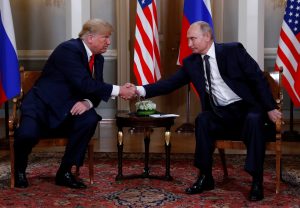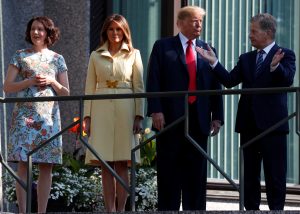
By Sarah N. Lynch and Susan Cornwell
WASHINGTON (Reuters) – U.S. President Donald Trump told Republican lawmakers on Tuesday he would back either of the immigration bills making their way through the House of Representatives, as the outcry grew over his administration’s separation of immigrant parents and children at the U.S.-Mexico border.
Representative Mark Meadows said Trump told Republican members of the House at a meeting on Capitol Hill that they needed to get something done on immigration “right away.”
In the meeting, Trump said separating families was “certainly not an attractive thing and does look bad,” added Representative Tom Cole.
Congressional Republicans have been scrambling to craft legislation as videos of youngsters in cages and an audiotape of wailing children have sparked anger at home from groups ranging from clergy to influential business leaders, as well as condemnation abroad.
A Reuters/Ipsos national opinion poll released on Tuesday showed fewer than one in three American adults supporting the policy. The June 16-19 poll found that 28 percent of people polled supported the policy, while 57 percent opposed it and the remaining 15 percent said they did not know.
Trump, who has made a tough stance on immigration a centerpiece of his presidency, has staunchly defended his administration’s actions. He has cast blame for the family separations on Democrats, although his fellow Republicans control both chambers in Congress and his own administration implemented the current policy of strict adherence to immigration laws.
The president has sought to link an end to the family separations to passage of a wider bill on immigration, which would include funding for his long-sought border wall with Mexico, prompting Democrats to accuse him of using children as hostages.
“In his remarks, he endorsed both House immigration bills that build the wall, close legal loopholes, cancel the visa lottery, curb chain migration, and solve the border crisis and family separation issue by allowing for family detention and removal,” White House spokesman Raj Shah said of Trump.
An unidentified person yelled an obscenity at the president before he entered the meeting.
Earlier on Tuesday, the president tried again to blame Democrats for what he called “loopholes” in the law that require families detained for entering the country illegally either to be separated or released.
“These are crippling loopholes that cause family separation, which we don’t want,” he said in remarks to the National Federation of Independent Business, adding he wanted Congress to give him the legal authority to detain and deport families together.

A U.S. border patrol truck drives along the border fence with Mexico and pass the Christo Rey Statue on Mt. Chirsto in Sunland Park, New Mexico, U.S. June 18, 2018. REUTERS/Mike Blake
BILL WOULD PREVENT SOME SEPARATIONS
House Republicans were working on a revised draft of one version of an immigration overhaul that would prevent family separations in some cases for those attempting an illegal border crossing for the first time, according to a House Republican aide.
The draft bill was seen just days ago as unlikely to pass, but has gained support in the House, and it was unclear whether the new language about preventing family separations would improve its chances for passage.
Both Republican bills under discussion, which have been blasted by Democrats and immigration advocacy groups, would fund the border wall and reduce legal migration, in part by denying visas for some relatives of U.S. residents and citizens who are living abroad, sometimes referred to as “chain migration.”
The more conservative bill from Representative Bob Goodlatte would also deny “Dreamers,” immigrants brought illegally to the United States as children, the chance of future citizenship.
Several hundred protesters marched in New York City, chanting “Keep families together!”
Anne Heaney, 74, a retired teacher, held a sign that read, “Children do not belong in cages. Maybe Trump and Pence do.”
In Washington, activists stood next to a table occupied by Department of Homeland Security Secretary Kirstjien Nielsen in a Mexican restaurant, voicing criticism of the administration’s policy, according to video obtained by Reuters.
Two top U.S. business groups, the U.S. Chamber of Commerce and the Business Roundtable, decried the separation policy on Tuesday and called for its immediate cessation.
“My heart goes out to the impacted families,” said JPMorgan Chase & Co Chief Executive Jamie Dimon, who chairs the Business Roundtable, in a memo to the bank’s employees. “Fixing these issues will clearly boost the economy,” he added.
Apple Chief Executive Tim Cook described the separation of children from parents at the U.S.-Mexico border as “inhumane” and promised to be a “constructive voice” in seeking to end the issue, the Irish Times newspaper reported.
Microsoft Corp CEO Satya Nadella called the policy cruel and abusive in an email to employees that was posted on Linkedin.com. He also said the company is not working on any projects with the U.S. government related to separating children from their families at the border.
U.S. Customs and Border Protection said on Tuesday that 2,342 children had been separated from their parents at the U.S.-Mexico border between May 5 and June 9.
The separations began after Attorney General Jeff Sessions announced in April that all immigrants apprehended while crossing the U.S.-Mexico border illegally should be criminally prosecuted.
Parents who are referred by border agents for prosecution are held in federal jails, while their children are moved into border shelter facilities under the custody of the Office of Refugee Resettlement, a Department of Health and Human Services agency.
LEGISLATIVE POSSIBILITIES
A number of Republican senators called on Trump on Tuesday to allow families to stay together if they had crossed the border illegally, and Senate leaders said their chamber could have legislation to address the family separations matter in a matter of days.
Senate Majority Leader Mitch McConnell said: “We hope to reach out to the Democrats and see if we can get a result, which means making a law and not just get into some kind of sparring back and forth that leads to no conclusion,” he said.
Top Democrats contended that Trump could change the policy with the stroke of a pen.
“The president is trying set this trap in the public mind that somehow there is a law requiring him to do this and Congress can undo it,” said Senator Chris Van Hollen, who visited a detention center in Brownsville, Texas, over the weekend. “We know this is a problem that was manufactured six weeks ago, and we’re seeing the awful results today.”
Decrying “internment camps,” Democrats and their supporters disrupted a U.S. congressional hearing on Tuesday about an FBI probe.
With the sound of a young child crying in the background, the top Democrat on the House of Representatives Judiciary Committee, Jerrold Nadler, broke from traditional protocol and started reading from a statement, saying: “These children are not animals.” His Republican colleagues tried to shout over him: “Out of order!”
(Reporting by Sarah N. Lynch and Susan Cornwell; Additional reporting by David Morgan, Amanda Becker, Tim Ahmann, Makini Brice, Doina Chiacu and Lisa Lambert in Washington, Alice Popovici in New York, Richard Lough in Paris and Tom Miles in Geneva; Writing by Doina Chiacu and Dan Burns; Editing by Frances Kerry and Peter Cooney)












